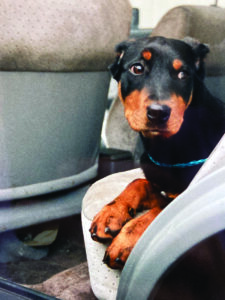
Most of us have had moments of anxiety in our lives, and while it’s not fun, most of us survive those moments and get over it. Similarly, most dogs also have those moments and can recover and carry on. It’s not so simple, however, with pathological anxiety.
Anxiety is a feeling of fear, dread, and uneasiness; having a sense of impending danger, panic, or doom. Anxiety gets categorized as pathological (extreme in a way that is not normal, but rather, characteristic of an illness or mental problem) when it continues or grows without environmental conditions justifying it. Pathological anxiety is uncontrollable by the dog.
Perhaps your dog is somewhat anxious about being walked near passing vehicles. You take care to walk her in low-traffic areas, but occasionally a car goes by. She spooks, jumps, looks worried for a moment or two, and then carries on with your walk. The pathologically anxious dog is a different story. She’s tense just going for a walk, in anticipation of the appearance of a dreaded vehicle. When one does appear, she may behave as if she thinks she is literally about to die. She panics, flails madly at the end of her leash (“freaks out” is how many owners describe this), and the walk is now spoiled for her. Trembling, she huddles in a pathetic puddle on the sidewalk. She can’t recover quickly; you may as well turn around and go home – if she can even walk. You may end up carrying her.
As frustrating and sometimes embarrassing as this may be for you, it’s much worse for her. It’s important to remember that your dog isn’t being “bad.” She is truly having a major panic attack and she cannot control her behavior. She needs empathy and the implementation of a behavior management and modification program to help her be able to better deal with her world.
COMMON MANIFESTATIONS OF ANXIETY IN DOGS
While any odd or random stimulus can be anxiety-producing for an individual dog, there are several circumstances that commonly trigger canine anxiety, which may range from a mild distress response in the presence of the stimulus to a full-blown panic attack. It is the panic-attack end of the range that is appropriately labeled “anxiety.” Here are some of the more common ones:
- Separation anxiety. This is probably the one we hear about most often – the dog who cannot tolerate being left alone. Extreme vocalization, house soiling, destructive behavior, and desperate attempts to escape are typical signs of separation anxiety.
- Noise anxiety. This is most noticeable in the dog who suffers greatly during thunderstorms and firework displays, but a sound-anxious dog can also panic at the sound of pans dropping on the floor, a far-off gunshot, a low-battery “chirp” from a smoke detector, or any other noise with which she has had a very negative experience (such as the warning beep of a shock collar). These dogs may panic and run away (hence the overcrowding in most shelter kennels on July 5th) or they may just shut down, panting and trembling violently.

- Car-ride anxiety. Often a result of the association with carsickness as well as the stress of the first ride and first separation from a pup’s family, car-ride anxiety often manifests as a dog’s increasing unwillingness to even approach the car, followed by constant panting and pacing once the ride starts.
- Specific-stimulus anxiety. Dogs can have a pathological anxiety response to any stimulus with which they have had a very significant negative past experience. Again, the dog’s behavior may range from a violent, panicked attempt to escape, to constant panting and pacing, or severe trembling and shutting down.
- Generalized anxiety. With generalized anxiety, the dog shows constant reactivity, restlessness, nervousness, trembling, and tension that interferes with a normal social interaction, often in the complete absence of any noticeable triggering stimulus. These dogs are in a constant state of anxiety, as opposed to specific-trigger anxiety.
LIVING WITH AND HELPING AN ANXIOUS DOG

The good news is that there are a number of things you can do to help reduce your dog’s anxiety and help her get through those difficult times:
1. Medication. First and foremost, a truly anxious dog needs pharmaceutical help – and, sooner rather than later. This is a quality-of-life issue, and the sooner you see your veterinarian about appropriate medication, the happier you and your dog will both be.
If your veterinarian is not behaviorally knowledgeable (it’s a complex field!), she can schedule a phone consult with a veterinary behaviorist for guidance on appropriate medications for your dog. If your vet does not already have a relationship with one, there is a complete list of veterinary behaviorists here: dacvb.org/about/member-directory
2. Comforting. There is absolutely nothing wrong with comforting your anxious or frightened dog. You are not at risk of “reinforcing the unwanted behavior” (as some people used to believe); you can’t reinforce emotion. Think how soothing it is for you to have someone comfort you when you are stressed. Then go and comfort your stressed dog!
3. Managing. We can’t say this frequently enough: The better you are at managing your dog’s environment to prevent her exposure to the conditions that cause her anxiety, the better life will be for her (and for you!). As you work to modify her anxiety, keeping her below her anxiety threshold as much as possible will help your modification efforts go more smoothly as well.
4. Products. There is an ever-growing list of products on the market designed to help your dog through episodes of anxiety. Many of them can be helpful, and it’s often a very individualized response – what helps one dog may be totally useless for the next. I put them in the “can’t hurt, might help” category and encourage my clients to try as many as possible to see what might work. (See “Products to Help Ease Your Dog’s Anxiety”)
5. Modification. All the above, by themselves, won’t “fix” your dog’s anxiety. You will also need to work to help her understand that she doesn’t need to panic about whatever it is that is triggering her extreme emotional response.
Carried out carefully, a program of habituation can help. This means just exposing your dog to the trigger stimulus at a very low intensity – a level at which she shows awareness but no distress whatsoever – and keeping it there until she doesn’t even notice it at all – then very gradually increasing the intensity, waiting for her to “not care” at each new level before increasing intensity again. (This can be impossibly hard to do with things like thunderstorms and fireworks!)
When you add treat-feeding to habituation you get counter-conditioning and desensitization – the mainstay of emotion-changing behavior modification.
Anxieties don’t get fixed quickly or easily, but with your loving attention to your dog’s emotional needs you can do a lot to help her have a better life.

It never hurts to supplement your management and modification with products that are known to aid in reducing your dog’s stress. Here are some:
Calming Shirts. Calming coats and snug t-shirts apply mild, constant pressure to a dog’s torso, surrounding a dog much like a swaddling cloth on a baby. Depending on the size of your dog, there are several brands and models to choose from. The original product on the market that addressed this was the ThunderShirt anxiety jacket; today the company makes a number of designs (see them at thundershirt.com). There are any number of imitators, too. You can do an internet search for “dog anxiety apparel” and find many to choose from.
Supplements. There are dog treats and over-the-counter products that contain supplements that have been proven to help anxiety. Typically, they will contain melatonin, thiamin, chamomile, L-theanine, and/or L-tryptophan. Some also contain ginger, which can help with sensitive stomachs. Note: If you use over-the-counter products sold for human use, check to be sure they don’t contain xylitol! Ask your veterinarian which ones she might recommend and would be comfortable with you giving to your dog.
Adaptil. This product is a synthetic substance that is meant to mimic the pheromones emitted by mother dogs when they are nursing their puppies. The natural pheromone is thought to help keep puppies calm; Adaptil purports to do the same for adult dogs. It’s easy to use; just plug the diffuser in an outlet in the room where your dog spends the most time. The diffuser releases “dog-appeasing” pheromones, an odorless scent particular to dogs. (It also comes as a spray that you can apply to a scarf when you take your dog out for walks or in the car and a collar your dog can wear.) Adaptil is available from your veterinarian and in most pet supply stores.
ZenCrate. The ZenCrate was designed to help dogs with a variety of anxiety factors and serves as an escape pod for your canine companion. It’s similar to a standard crate but it provides vibration isolation, noise cancellation (through sound insulation), reduced light, as well as comfort and security. A motion-activated sensor turns on a gentle fan when your dog enters, which helps block noise and provides a steady stream of fresh air. You can pre-program the crate with music. It comes with a removable door, so your dog can self-comfort and enter at any time. See zendogcrate.com for more information.
Calming Sounds. The time-proven iCalmDog music can be useful to help soothe anxious dogs. Originally known as “Through a Dog’s Ear,” this music is “psychoacoustically designed” to trigger relaxation (for more information about how this is accomplished, see icalmpet.com/about/music/). The products are available as downloadable sound files or on CDs or microSD cards, or can be streamed through major streaming platforms. Check out the company’s complete offerings at icalmpet.com.






I adopted a Labrador/husky mix, 11 months old, 3 weeks ago. She is doing well in house and yard. I have one problem, she doesn’t want to go for walks. I have been taking her out every day and make it a few hundred yards and she stops and sits down. Tried throwing treats in front of her, she grabs them and sits again. I have tried to walk with friends, but same happens. Walks a little and stops. have gone to the park with friend and dog and we manage to get a 1 mile walk in with lots of stops and treats. How can I convince her that walks are fun.
She is physically in good shape. Had her checked out by vet.
Hope you can help on how to solve this problem.
Regards,
Johanna Hayes
I’d recommend using Dr. Utu Herbal Cure topically for instant pain and itch relief as well as accelerated healing of lesions and permanently stopping herpes virus outbreaks. I have tried just about everything from acyclovir suppressive therapy to different natural oils, extracts, and other natural methods, some of which are EXTREMELY painful and exacerbate the problem (i.e. apple cider vinegar!). While vitamin E oil and suppressive therapies worked well for me, when I became pregnant I went back to trying to find a herbal cure. I was using vitamin E oil topically for a while but it was thin and difficult to use and only seemed to prevent further outbreaks rather than getting rid of it. I contacted Dr. Utu Herbal Cure through my friend. To my surprise, I could tell my outbreak was starting to heal within only a few hours! No more itching and pain! Dr. Utu Herbal Cure that I used was liquid herbs in bottles, so it was very easy to use. It simply whiffs, but it works so I don’t care! The best part of my testimony was that I successfully delivered a herpes-free beautiful daughter without further medications. Anyone who has tried Dr. Utu Herbal Cure knows just how quickly those treatments can add up.
Anyone can reach Dr. Utu through
drutuherbalcure@gmail,,,.com
+2349072733661
I adopted a 4 year old Mini Aussie about 3 months ago . I don’t think shes had an easy life up til now. She has only what I can call Panic attacks in a crate.
And is deathly afraid of thunderstorms and is nervous in a car and will usually throw up at least once but after that she usually will lay down and goes to sleep. So not sure if that’s all stress or maybe some motion sickness on top of it.
She does seem to have a nervous nature.
Anyway
I have tried many things already.
Nothing seems to help and hasn’t even begun the to the edge off for her.
She won’t eat any treats except for chicken pieces and popcorn so I’m going to use those for training.
And she hasn’t chewed any bones or chews I have offered her ( which has been a variety ) and she does not play with any toys at all. So for me she is a bit of a strange bird!
But last owner said she was the same with her as far as treats, toys and chews. And I can only assume she was the same about the crate and thunderstorms.
We are at least her 3rd home. There is a year that last owner could not account for so we could very well be her 4th home.
I have tried CBD oil, homeopathy , Flower essences including Rescue Remedy, soothing music, loud Tv to help drown out the noises and a Thundershirt but nothing has helped calm her yet.
She pants very rapidly, drools, shakes uncontrollably and sometimes whines and is just inconsolable.
She sticks right with me but nothing I do seems to help her so I have just started letting her be with me and try to ignore everything and talk to her and act as if nothings wrong ,
I would really love to work this out naturally for her but with all the failed attempts so far I am feeling like I need to contact the vet for some type of medicine which I hate cause I hate having to have her on a medication the rest of her life for this.
I do have a relaxing CD that has showers and thunderstorms on it and I plan to start playing it very low in the back ground and see if maybe I can get her more accustom to the noise as you stated in your article.
I’ll try anything at this point and appreciate any and all the helpful suggestions I can get to help her cause I hate to have drug her for every storm that comes through or every time I have to crate her or go somewhere in the car with her.
I should mention I am home all day with her so she is not left in a crate or outside all day as I fear might of been the case with previous owners. She is inside right with me all day every day. Unless I have to run to town or have some sort of appt. which is not often at all.
We live in Fl right now so we get lots of storms coming through so its something I need to figure out sooner than later for her sake.
And in all honesty it’s rather stressful watching her have to go through this and not being able to help her at all.
Help. We rescued a 35 lb hound dog from the local shelter…he is amazing while we are home. We left for dinner tonight and came home to find he had broken out an upstairs bedroom window and jumped to the ground below!!!!! We are terrified for him…he has minor cuts on his legs and tummy, but he could have killed himself….He has the same worst separation anxiety I have ever witnessed…we have a 2byr old son who loves him and Huck loves him, but when we leave he finds away out of our house…but tonight was the worst..!!!!!! Please help what can we do, we don’t want to return him, we want to help him….he chewed through a steel lead, a steel crate and now out a second story window!!!! OMG…What do we do. Its not always possible to take him with us, plus we cannot leave him in our car…. please help us….and Huck.
Hello! Firstly you need a real “diagnosis” – is this separation related anxiety, or could it be a noise phobia? I had a Cairn who tried to get out of the house, the owners didn’t realise what was happening. He turned out to be terrified of the blinds banging on the windows.
It may take an experienced behaviourist to suss this out. It’s not always obvious and the dog may not show the behaviour when owners are there, depending on what it is.
For separation anxiety, check out Julie Naismith SA Pro Trainers or Malena’s CSATs. You need people who specialise in this.
Good luck.
PS crated dogs may panic and damage themselves. A specialist will talk this through with you. Please ensure you find a reward based, highly qualified person. Or it will be wasted money and we all only have so many spoons!
Zencrates has been out of business for several years now.